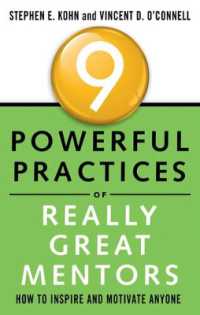- ホーム
- > 洋書
- > ドイツ書
- > Humanities, Arts & Music
- > History
- > antiquity
Description
(Text)
Il volume analizza la presenza di Dioniso nelle fonti letterarie e iconografiche cristiane, tra II e IV secolo, con lo scopo di comprendere il ruolo giocato dal dio greco nella formazione dell'identità cristiana. L'incontro tra le tradizioni dionisiache e le fonti cristiane è collocato nella prospettiva di studi che rimuove il cristianesimo dalla sua separatezza e diversità teologica per ricollocarlo nelle complesse dinamiche religiose dei primi secoli d.C., come una componente del panorama religioso dell'Impero romano. Situandosi nell'ambito degli studi sulle competizioni e sulle coabitazioni religiose dell'età imperiale, la ricerca si sviluppa intorno a tre strategie adottate dai cristiani nei confronti di Dioniso e del suo mondo: il riconoscimento e la negazione delle analogie tra il dio greco e Cristo, la ripresa di parole e immagini dionisiache per la ricostruzione del linguaggio letterario e iconografico cristiano, le interpretazioni e mediazioni culturali cristiane di tematiche dionisiache.
---
The analysis of the role of Dionysus in the process of forming an Christian identity during the imperial ages (2nd-4th century) is at the center of this study. Its main purpose is that of understanding the part that Dionysian traditions played in the encounter of Christianity and the religions of the Greek and Roman worlds. With this analysis three operative models have been identified: 1. the recognition and negation of the analogies between Dionysus and Christ; 2. the trace of Dionysian words and images; 3. the Christian interpretation of Dionysian topics.
This scheme shows the complexity inherent to the cohabitations and to the religious contacts of the imperial time. With the analysis of some important authors of Christian literature and of distinct figurative documents, this book finds, on the one hand, the aspects which enabled the Christian reconfiguration of the Dionysian elements and, on the other hand, the modalities of neutralization of the Dionysian images and vocabulary.
(Review)
"The great value-and pleasure-of reading 'Tra la vigna e la croce' is the subtlety with which Massa disentangles these promiscuous vines, identifying the multiple and sometimes contradictory uses of images held in common by two very different, but also startlingly similar, religious communities." James Hume Bryn Mawr Classical Review, 2016.10.29
(Author portrait)
Massa, Francesco
Francesco Massa, PhD in History of ancient religions (EPHE, Paris and FSC, Modena), is presently working as Post-doctoral Research fellow at Aix-Marseille University. His research focuses on aspects of the cultural and religious history of Antiquity, in particular on the interaction between "Pagans" and "Christians" (2nd-4th century). Francesco Massa, dottore di ricerca in Storia delle religioni antiche (EPHE, Parigi e FSC, Modena), è attualmente ricercatore postdoc all'Università di Aix-Marseille, dove è membro del Centre Paul-Albert Février (UMR 7297 TDMAM). I suoi lavori si concentrano su diversi aspetti della storia culturale e religiosa dell'Antichità, con particolare attenzione ai rapporti tra "pagani" e "cristiani" tra II e IV secolo.






